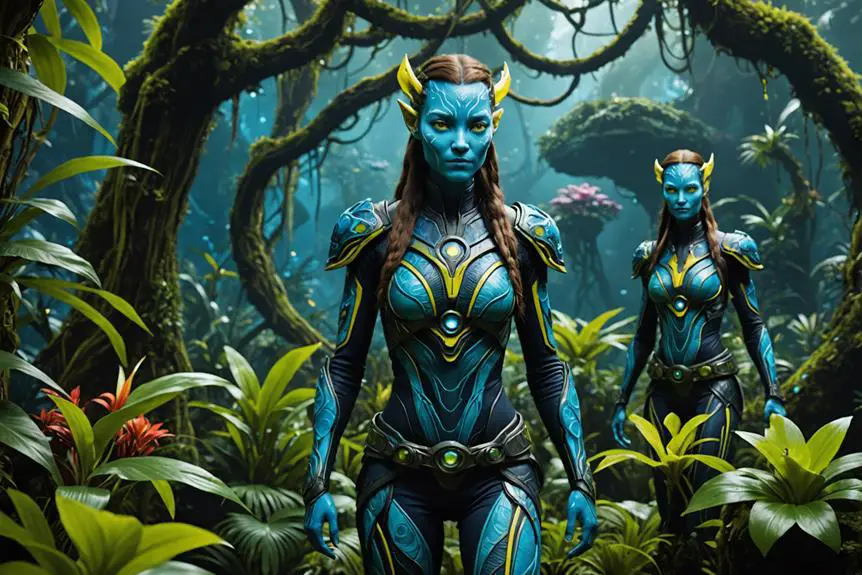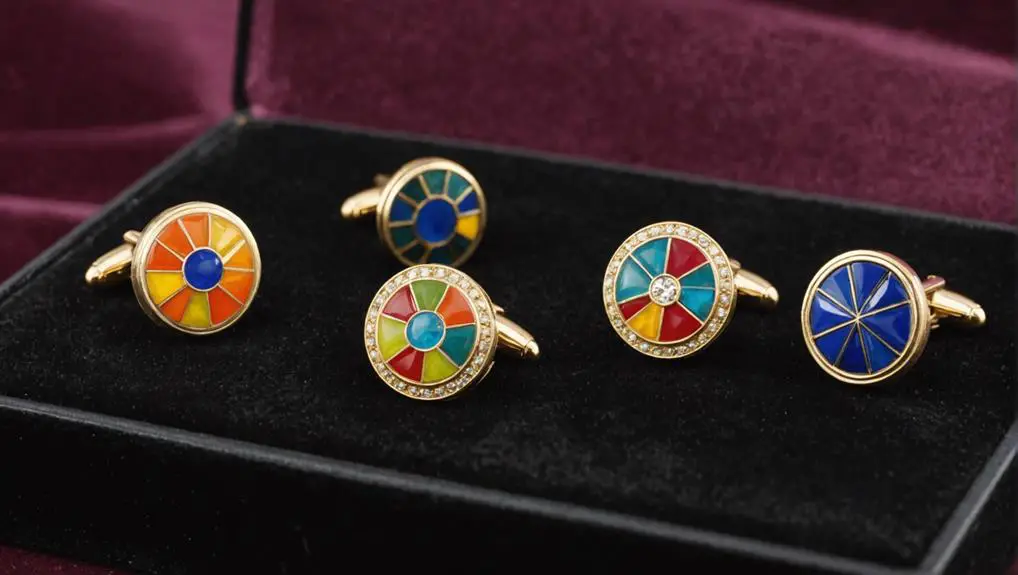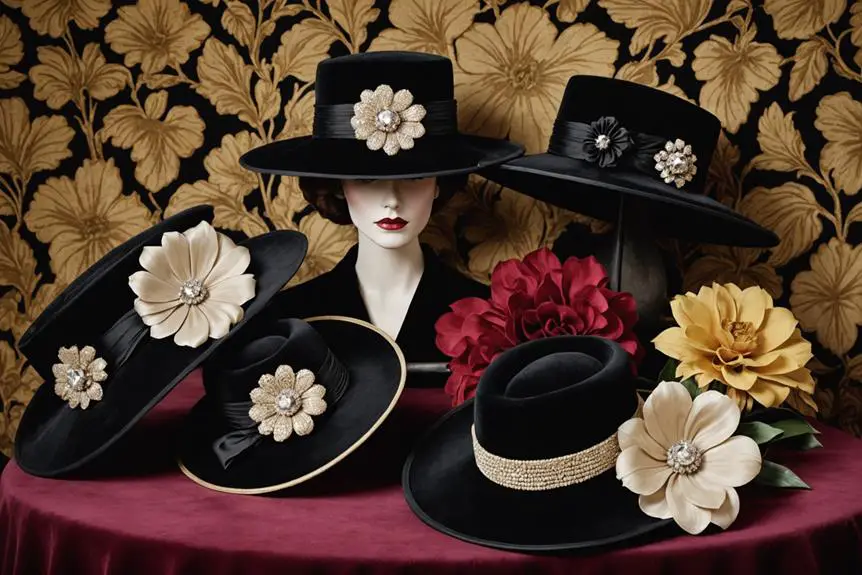When you consider the outfits in "Avatar: The Way of Water," it's clear they do more than simply adorn the characters; they embody the essence of their cultures and narratives. You might notice how each costume reflects specific clan identities, drawing inspiration from Polynesian traditions and vibrant textiles. This careful attention to detail raises questions about the intricate relationship between costume design and storytelling. What challenges did the designers face in bringing these visions to life, and how might these choices impact your perception of the film? Let's explore further.
Costume Design Overview
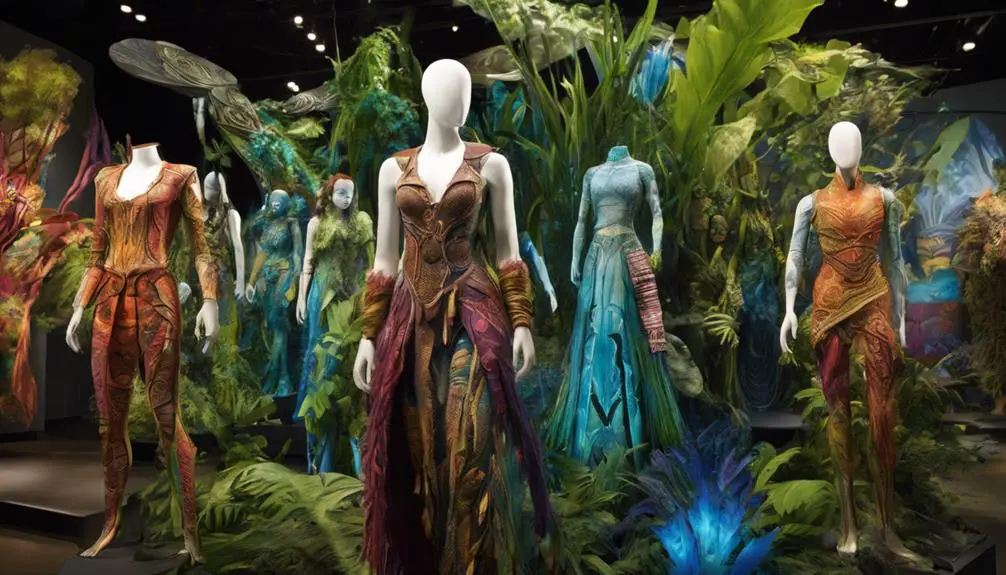
Costume design for "Avatar: The Way of Water" dives deep into the creative process, showcasing the dedicated efforts of Academy Award-winning designer Deborah L. Scott. Beginning in Spring 2018, Deborah committed nearly six years to craft stunning outfits that bring the world of science fiction to life. Her designs for the Na'vi characters reflect an impressive palette of high-contrasting colors and unique textiles, drawing inspiration from extensive research on indigenous cultures, particularly the Polynesian influences evident in the Metkayina clan.
You'll appreciate how Deborah collaborated closely with the cast, starting with initial artwork to create stage pieces that mimic costumes for performance capture. This approach guarantees both actor comfort and authentic character representation, allowing you to fully immerse yourself in the story. Realistic costume design is essential for audience immersion, especially considering that much of the film unfolds underwater. Deborah paid special attention to how garments interact with water dynamics, enhancing the visual experience.
Furthermore, the integration of traditional costume design with digital artistry is impressive, with over 10,000 drawings created to breathe life into each character. Deluxe Jake and his fellow Na'vi embody this intricate craftsmanship, showcasing how costume designer Deborah seamlessly blends artistry and technology. As you explore the film, you'll find that each costume not only serves a purpose but also adds depth to the narrative, making it an unforgettable visual feast.
Cultural Influences on Costumes
The cultural influences on the costumes in "Avatar: The Way of Water" reflect a deep respect for the diverse traditions of indigenous peoples, particularly those from Polynesian backgrounds. Costume designer Deborah Scott and her team conducted extensive research to guarantee authenticity, drawing inspiration from indigenous cultures around the world, especially those living near water. This dedication is evident in the way the Metkayina clan's costumes emphasize natural materials and environmental adaptations, which are vital for their aquatic lifestyle.
Deborah was able to create outfits that embody clan identity and status through color, structure, and distinctive styles. Each costume signifies different roles within the community, whether it's a leader or a fisherman, highlighting the importance of social hierarchy. The balance between minimalistic and decorative styles showcases both the functional aspects of their clothing and the aesthetic qualities unique to Na'vi culture.
Incorporating real shells and traditional weaving techniques not only enhances the costumes' authenticity but also pays homage to the craftsmanship of indigenous peoples. These choices reflect a commitment to representing the rich tapestry of cultures that inspired the film, allowing audiences to appreciate the depth behind the visuals. Through Deborah Scott's vision and dedication, the costumes in "Avatar: The Way of Water" become not just clothing, but powerful symbols of identity, heritage, and respect for the earth, truly enriching the cinematic experience.
Character-Specific Outfits
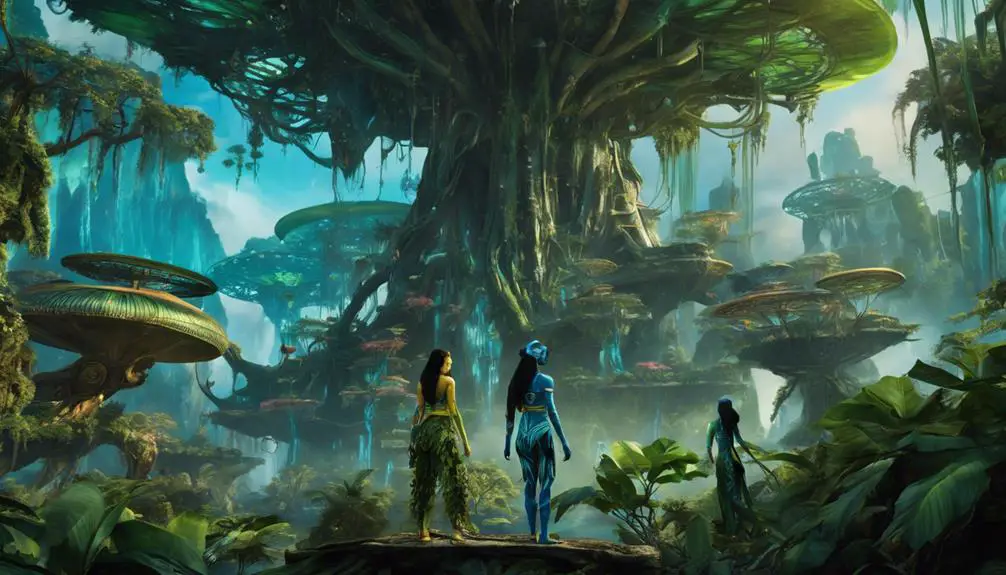
Bringing to life the spirit of the Na'vi, character-specific outfits from "Avatar: The Way of Water" offer fans a chance to step into the shoes of their favorite heroes and heroines. Each costume not only reflects the unique aesthetics of characters like Neytiri and Jake Sully but also symbolizes their character evolution throughout the story. For instance, the Neytiri Deluxe Adult Costume, priced at $66.95, showcases intricate details and vibrant colors that echo her fierce and nurturing nature, while the Jake Sully Deluxe Adult Costume, available for $51.95, highlights his journey as a protagonist through designs that balance functionality with cultural significance.
Younger fans aren't left out, as tween costumes for characters like Jake and Tsireya are available for $39.95 and $37.95, respectively, allowing them to embody their favorite characters and engage with the franchise. The classic versions of Neytiri and Jake Sully costumes offer iconic looks that emphasize their distinct traits, priced between $51.95 and $66.95.
These outfits serve as powerful tools for fan engagement, allowing you to connect with the narrative on a deeper level. As you don these costumes for themed events, cosplay, or Halloween celebrations, you're not just wearing a costume; you're embracing the essence of the Na'vi, celebrating the symbolism woven into each design, and experiencing the magic of Pandora. So, gear up and get ready to immerse yourself in the world of "Avatar"!
Technical Challenges in Costume Creation
Creating the stunning outfits seen in "Avatar: The Way of Water" presented unique technical challenges that went beyond traditional costume design. Since much of the film unfolds underwater, designers had to carefully consider how garments would interact with underwater dynamics. This meant that every stitch and seam had to account for the fluidity of movement in water, guaranteeing that the costumes maintained their form while appearing natural and vibrant on screen.
Na'vi tailoring posed its own set of challenges, as the nine-foot-tall characters required innovative approaches to accommodate their size and physicality. Designers had to think creatively about how to create garments that allowed for freedom of movement while still looking visually striking. Extensive fabric testing became essential, as it informed animators about how different materials would behave in an aquatic environment.
To achieve the highest level of realism, the design team even submerged fabric in water to study its movement and visual translation on screen. This hands-on approach guaranteed that the costumes would effectively integrate with the breathtaking visual effects. Additionally, digital artists played a significant role in the process, conducting virtual fittings to recreate costumes with intricate details and textures. This collaboration allowed for a seamless integration of costume design and animation, ultimately bringing the enchanting world of Pandora to life. The result is a stunning array of outfits that not only look incredible but also enhance the overall storytelling of the film.
Material Choices and Sustainability
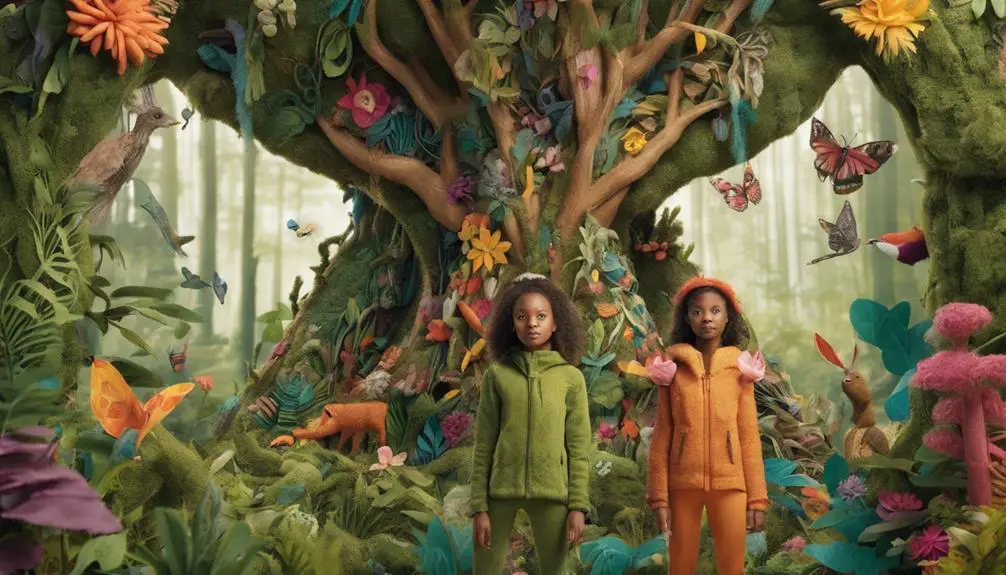
Emphasizing sustainability, the costume design for "Avatar: The Way of Water" prioritized natural materials like hides, shells, and plants. This approach not only showcases a deep respect for the environment but also reflects indigenous practices that utilize available resources for clothing creation. By focusing on ethical sourcing, the design team guaranteed that every material used was selected with care, underscoring a commitment to sustainable practices. Additionally, the tailoring techniques involved in crafting these costumes echo the art of vintage clothing adjustments, emphasizing the importance of fit and functionality while maintaining aesthetic appeal.
The costumes of the Metkayina clan were informed by extensive research on Polynesian culture, emphasizing cultural authenticity alongside sustainability. Techniques like weaving and braiding were incorporated, highlighting traditional craftsmanship while utilizing renewable materials. Imagine the beauty of costumes enhanced by real shells, integrated to promote authenticity and reduce reliance on synthetic alternatives—this is a reflection of the team's dedication to preserving natural beauty.
Moreover, the use of 3D printing in costume design allowed for the creation of intricate, complex pieces that balanced strength and delicacy. This innovative approach not only pushed creative boundaries but also reinforced sustainable practices within the industry. By marrying technology with a commitment to the environment, the designers contributed to a future where costumes can be both stunning and responsible.
In essence, the material choices in "Avatar: The Way of Water" exemplify a harmonious blend of creativity, culture, and sustainability. You can admire how these choices enhance the film while promoting a greater message about respecting our planet and its resources.
Role of Costume in Storytelling
Costumes in "Avatar: The Way of Water" play an essential role in shaping the narrative and deepening character connections. They're not just clothes; they embody character identity and enhance storytelling in profound ways. Each outfit reflects the unique traits of the Na'vi and human characters, showcasing their backgrounds and roles within the story. For instance, specific designs signify leadership, while other styles represent fishermen or children, adding layers of visual symbolism that enrich the narrative depth.
Deborah L. Scott's dedication to cultural authenticity shines through the costumes, which were meticulously crafted based on extensive research into indigenous cultures. This attention to detail guarantees that the film resonates with audiences, allowing them to connect with the characters on a deeper level. Furthermore, the innovative use of digital technology in costume design means every detail is captured with remarkable precision, making characters feel more realistic and relatable.
The movement of fabrics, especially in water dynamics, creates a powerful visual storytelling element. As characters interact with their environment, their costumes respond, influencing how you perceive their emotions and actions. This interplay of design and movement not only captivates your attention but also invites you to engage with the characters' journeys more intimately. Ultimately, the costumes in "Avatar: The Way of Water" do more than adorn the characters; they breathe life into the story, making it a rich and immersive experience that you won't soon forget.
Future of Costume Design
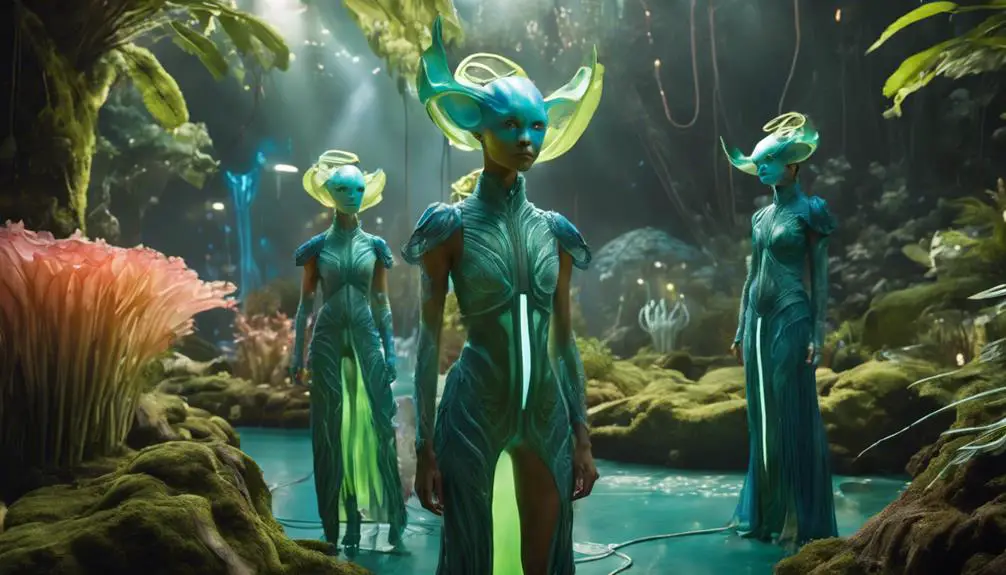
With advancements in visual effects technology, the future of costume design is poised for a transformative leap. You're entering an era where traditional costume design meets digital innovation trends, creating opportunities for breathtaking visuals and enhanced storytelling. Imagine costumes that not only look stunning but also react dynamically to the environment, pushing the boundaries of what's possible in film.
As filmmakers explore immersive experiences, the collaborative processes become even more critical. Costume designers, digital artists, and animators are working together like never before, ensuring that each element complements the others seamlessly. This teamwork results in breathtaking garments that move authentically, as seen in Avatar: The Way of Water, where meticulous attention to detail sets a new standard for realism.
Future designs are expected to incorporate cutting-edge materials and dynamic fabrics, enhancing storytelling depth and character development. Just picture costumes that change in response to a character's emotions or surroundings, creating a deeper connection with the audience. This evolution not only elevates visual aesthetics but also enriches the narrative, making every scene more engaging.
As you look ahead, it's clear that costume design will continue to evolve, marrying tradition with technology in exciting new ways. The possibilities are endless, and the future is bright for costume designers willing to embrace these innovations. Get ready to witness a new wave of creativity that will change how you experience films forever!
Popular Avatar Costume Options
As the future of costume design embraces innovative technologies, fans of the Avatar franchise can enjoy a wide range of popular costume options that bring their favorite characters to life. Whether you're channeling the fierce Neytiri or the courageous Jake Sully, there's something for everyone. The Deluxe Neytiri Adult Costume, priced at $66.95, and the Deluxe Jake Sully Adult Costume for $51.95 are crafted to reflect the unique aesthetics of their respective characters, offering a fantastic choice for serious cosplayers.
For those on a budget, classic versions of both costumes provide affordable alternatives, ensuring that fans can participate in themed events without breaking the bank. Tween costumes for characters like Jake and Tsireya range from $37.95 to $39.95, catering to younger fans and encouraging early engagement with the franchise.
To enhance your portrayal, consider character-specific wigs like the Avatar Adult Deluxe Neytiri Wig for $39.99 and the Men's Avatar Deluxe Jake Wig for $29.99. These accessories not only elevate your look but also align with character popularity trends, making you a standout at any gathering. Complement your costume with the Avatar Na'vi Weapon for $14.99, adding that authentic touch to your ensemble.
With these diverse costume pricing strategies and engaging fan activities, you're set to immerse yourself in the vibrant world of Avatar, celebrating your favorite characters in style!
Frequently Asked Questions
What Are the Clothes That Avatars Wear?
The clothes avatars wear showcase Na'vi fashion, featuring vibrant colors and bioluminescent patterns. These garments reflect their cultural significance, embodying a deep connection to nature and clan identity, while promoting movement and expression in their environment.
Who Made the Costumes for Avatar?
The costumes for Avatar were crafted by Deborah L. Scott, emphasizing costume design that reflects character development. She explored cultural influences, ensuring authenticity while collaborating closely with the cast throughout the extensive design process.
What Were the Inspirations for the Avatar Movie Franchise Costumes?
Like a tapestry woven from diverse threads, the Avatar costumes draw from cultural influences, intertwining character design with color symbolism. They reflect the essence of their environments, enhancing both storytelling and the characters' deep-rooted identities.
What Is Avatar Disney Movie?
"Avatar" isn't just a movie; it's a visual masterpiece showcasing Na'vi culture through stunning CGI technology. It explores deep environmental themes, emphasizing the importance of nature and connection, resonating with audiences worldwide.
